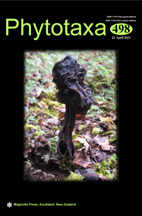Abstract
Ceropegia rudatisii Schlechter was first collected in KwaZulu-Natal, South Africa in 1903 but described in 1905 based on a second independent collection. This Ceropegia species was not seen again for a century and believed to be extinct. In 2020, however, two very small populations were discovered not far from the type locality. The subsequent examination of living flowering plants allowed an updated morphological description and, for the first time, illustration of C. rudatisii with photographs of living flowering plants and details thereof. We provide a comprehensive species description including novel aspects and details, i.e. bracts, inner corolla colouration, pollinarium and pollinia, as well as posture of corolla lobe tips of fresh flowers in situ—being not suberect-spreading, as given in earlier treatments, but flaccid-pendulous. The conservation status of C. rudatisii according to IUCN Red List criteria is furthermore discussed. Conservation measures are indispensable and urgent to avoid the extinction of C. rudatisii.

